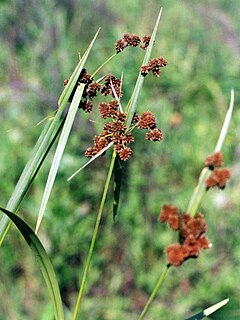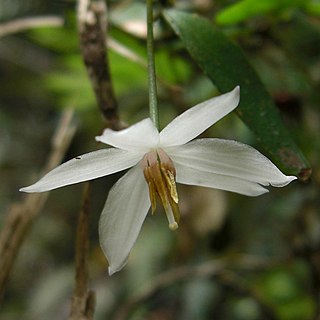
Toxicodendron radicans, commonly known as eastern poison ivy or poison ivy, is an allergenic Asian and Eastern North American flowering plant in the genus Toxicodendron. The species is well known for causing urushiol-induced contact dermatitis, an itchy, irritating, and sometimes painful rash, in most people who touch it. The rash is caused by urushiol, a clear liquid compound in the plant's sap. The species is variable in its appearance and habit, and despite its common name, it is not a true ivy (Hedera), but rather a member of the cashew and pistachio family (Anacardiaceae). T. radicans is commonly eaten by many animals, and the seeds are consumed by birds, but poison ivy is most often thought of as an unwelcome weed. It is a different species from western poison ivy, Toxicodendron rydbergii, which has similar effects.

Campsis radicans, the trumpet vine or trumpet creeper, is a species of flowering plant in the family Bignoniaceae, native to the eastern United States, and naturalized elsewhere. Growing to 10 m (33 ft), it is a vigorous, deciduous woody vine, notable for its showy trumpet-shaped flowers. It inhabits woodlands and riverbanks, and is also a popular garden subject.

Scirpus is a genus of grass-like species in the sedge family Cyperaceae many with the common names club-rush, wood club-rush or bulrush. They mostly inhabit wetlands and damp locations.

Totora is a subspecies of the giant bulrush sedge. It is found in South America, notably on Lake Titicaca, the middle coast of Peru and on Easter Island in the Pacific Ocean. The genus Schoenoplectus is closely related to Scirpus and sometimes included therein. This plant can reach a height of 6 m (20 ft) and commonly reaches 4 m (13 ft). The word totora comes from the Quechua language.

Ficinia nodosa, the knotted club-rush or knobby club-rush, is a rhizomatous perennial in the family Cyperaceae, native to South Africa, Australia, and New Zealand. Widespread in the Southern Hemisphere, Ficinia nodosa grows to between 15 and 220 cm in height. Although F. nodosa grows best in sandy, salty soil, the plant grows in a wide variety of environments from coastal sand dunes to alpine regions. F. nodosa’s appearance is characterised by dense clusters of long green stems topped with small, rounded flowers often remaining throughout the year.
Drosera radicans is an erect perennial tuberous species in the carnivorous plant genus Drosera. It is endemic to Western Australia and is only found in a relatively small area north of Geraldton. It grows in winter-wet areas in sand or sandy clay soils. D. radicans produces small carnivorous leaves along stems that can be 7–18 cm (3–7 in) high. White flowers bloom from August to September.

Isolepis cernua is a species of flowering plant in the sedge family known by the common names low bulrush, slender club-rush, tufted clubrush, and fiberoptic grass. It is widespread, being native to many regions of the world, including parts of Australasia, Eurasia, Africa, and North and South America.

Schoenoplectiella mucronata is a species of flowering plant in the sedge family known by the common names bog bulrush, rough-seed bulrush, and ricefield bulrush. It is native to Eurasia, Africa and Australia. It grows in moist and wet terrestrial habitat, and in shallow water. It is a perennial herb growing from a short, hard rhizome. The erect, three-angled stems grow in dense clumps and can reach a metre tall. The leaves take the form of sheaths wrapped around the base of stem, but they generally do not have blades. The inflorescence is a headlike cluster of cone-shaped spikelets accompanied by an angled, stiff bract which may look like a continuation of the stem.
Bolboschoenus robustus is a species of flowering plant in the sedge family. It is known by many common names: saltmarsh bulrush, alkali bulrush, sturdy bulrush, seacoast bulrush, stout bulrush, three-cornered sedge or leafy three-cornered sedge, and seaside club-rush.

Poison ivy is an allergenic plant in the genus Toxicodendron native to Asia and North America. It is well known for causing urushiol-induced contact dermatitis, an itchy, irritating, and sometimes painful rash, in most people who touch it. The rash is caused by urushiol, a clear liquid compound in the plant's sap. The plant is variable in its appearance and habit, and despite its common name, it is not a true ivy (Hedera), but rather a member of the cashew and pistachio family (Anacardiaceae). T. radicans is commonly eaten by many animals, and the seeds are consumed by birds, but poison ivy is most often thought of as an unwelcome weed. Poison ivy was formerly treated as a single species, Toxicodendron radicans, but is now generally treated as a complex of three separate species: Toxicodendron radicans, Toxicodendron rydbergii and Toxicodendron orientale.

Isolepis is a cosmopolitan genus of sedge containing around 70 species. Isolepis is found in cool tropical and temperate climates often in Africa and Australasia.

Scirpus atrovirens, known as dark-green bulrush, is a perennial sedge native to wetlands of eastern Canada and the United States. It is sometimes called dark green bulsedge, black bulrush, or green bulrush.

Luzuriaga radicans (quilineja) is a species of flowering plant in the genus Luzuriaga of the family Alstroemeriaceae (Inca-lilies), part of the monocot order Liliales.

Scirpus sylvaticus, the wood clubrush, is a species of flowering plant in the sedge family.

Schoenoplectiella juncoides is a sedge, native to east Asia and Oceania. It is a serious weed of rice paddies.

Begonia radicans, the shrimp begonia, is a species of flowering plant in the genus Begonia, native to southeastern and southern Brazil. It has gained the Royal Horticultural Society's Award of Garden Merit.
Polylychnis is a genus of flowering plants belonging to the family Acanthaceae.
Habroneuron is a genus of flowering plants belonging to the family Rubiaceae.
Nodocarpaea is a genus of flowering plants belonging to the family Rubiaceae.
Rhodoscirpus is a monotypic genus of flowering plants belonging to the family Cyperaceae. The only species is Rhodoscirpus asper. It was reclassified from the previous Scirpus asper.













